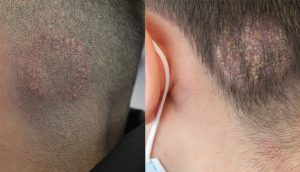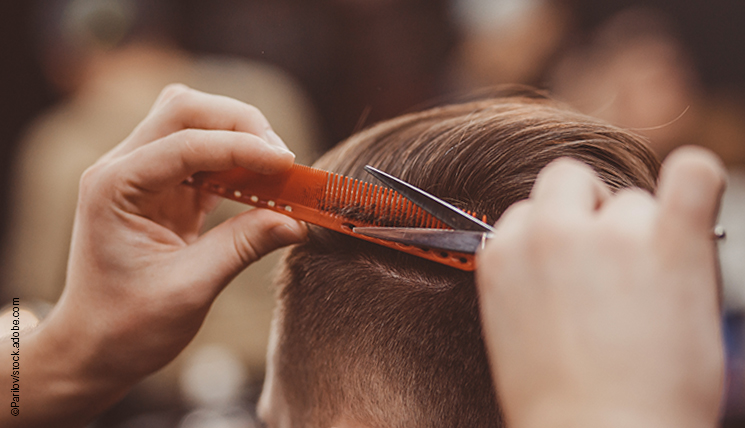Guest contribution:
 Article series on the subject of state-of-the-art mycology in dermatology,
Article series on the subject of state-of-the-art mycology in dermatology,
12th article
by Prof Hans-Jürgen Tietz, Director of the Institute of Fungal Diseases in Berlin, Germany
Mycoses spring in every nook and cranny. It is not only a recent phenomenon that patients get a fungal infection with their haircut, but since the easing of the COVID restrictions in this sector, the golden and silver combs are particularly busy again.

While it used to be the highly contagious M. audouinii (formerly known as the “orphanage fungus”) that people brought back to Germany from beach hair styling on their summer holidays in Majorca, these days it is T. tonsurans which is increasingly pestering hair salon customers. I have included a recent example, shown before and after insufficient local therapy (fig. 1). Since then, an additional systemic therapy was started. The drugs of choice are fluconazole and itraconazole.
T. tonsurans owes its name to the image of a tonsure on the head and used to be considered extinct in Germany until it was brought back from the US by wrestling teams from Würzburg and Berlin in the 90s. Since then, it is endemic and particularly widespread and feared in martial arts as “wrestler’s fungus”. Despite all the rules, it is seen as ineradicable and just a part of martial arts. My close mycology colleagues and friends Dr Nenoff from Leipzig and Dr Malisiewicz from Frankfurt regularly experience this in their practice. An 8-year-old patient once told me: “You know what, doctor? The whole Bundesliga looks like me.” Tinea corporis gladiatorum had even reached the national team back then. “I’d rather cover these parts than be excluded from the competition.” Curing and educating patients on why that is exactly what you should not do led to a friendly invitation for a presentation at the German association of wrestlers, the “Ringer-Bund”.
T. tonsurans is an allrounder, a multi-talent. Apart from Tinea corporis and capitis, which primarily spreads in nurseries, T. tonsurans is even – to stay in today’s theme – the “no. 1” among the onychomycosis pathogens in the US.
Additionally, the species has several variants. The most important variant is the sulphur-yellow Variato sulfureum. In the present case, the pathogen behaved strangely: its growth was very slow and later stopped completely. We have seen this kind of strain frequently before, which other mycologists have not yet been able to confirm. Maybe it has to do with the medium.

Whatever the reason, it is easy to perform a PCR with an atypically grown culture, which is also epidemiologically important. The PCR result was clear: T. tonsurans (fig. 2). This does, however, not solve the problem of wrestling mats and barber shops – skilled epidemiologists are needed for this, also in mycology.
Sincerely, Hans-Jürgen Tietz
The articles under the rubric “Guest contribution” only reflect the views of the respective authors. Responsibility for the legality and content of the articles lies solely with the authors. EUROIMMUN does not assume liability for the completeness, accuracy and currentness of the information provided.
